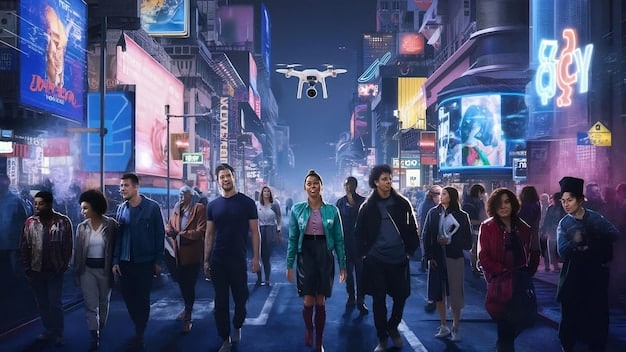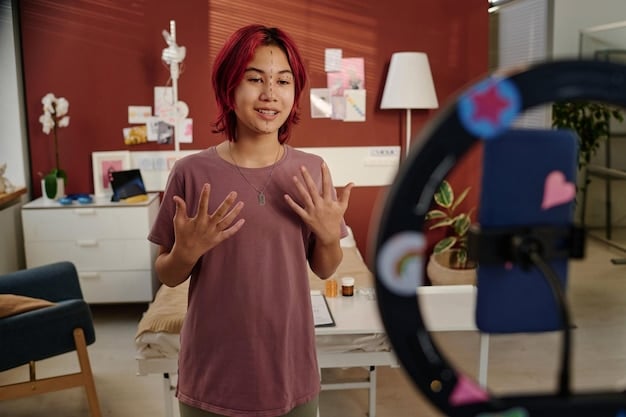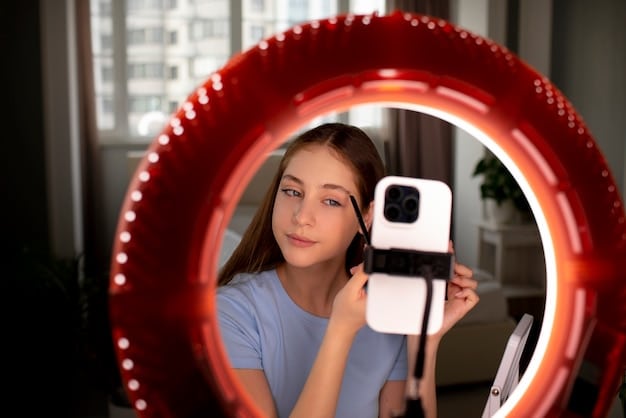Virtual Influencers: The Future of Pop Culture in the US?

The rise of virtual influencers marks a significant shift in US pop culture, raising the question of whether these AI personalities represent the future of digital entertainment and marketing.
Are AI-generated personalities poised to redefine pop culture in the United States? The rise of virtual influencers: are AI personalities the future of pop culture in the US? is no longer a futuristic fantasy but a present-day reality reshaping how brands connect with audiences and how individuals perceive celebrity.
Understanding Virtual Influencers
Virtual influencers are computer-generated characters that possess realistic features, behaviors, and personalities. They engage with audiences on social media platforms, much like human influencers, promoting products, sharing experiences, and advocating for causes.
These digital entities are not mere avatars; they are meticulously crafted creations designed to resonate with specific demographics and foster a sense of connection and authenticity. This rise has sparked considerable debate and fascination within the marketing world, raising questions about the future of advertising and celebrity culture.
The Anatomy of a Virtual Influencer
Virtual influencers are complex creations. Sophisticated software and skilled artists are required and a lot of thought goes into developing these digital personas.
- Visual Design: Lifelike rendering and appealing aesthetics are essential to attracting followers.
- Personality and Backstory: Each influencer has a unique history and personality traits, allowing for deeper engagement.
- Content Strategy: Regular, engaging content aligned with brand values and audience interests is crucial.
The careful crafting of these elements is what blurs the line between real and virtual, making these influencers so effective.

The Appeal of AI Personalities
The appeal of virtual influencers lies in their controlled nature, cost-effectiveness, and ability to transcend the limitations of human influencers. Brands can meticulously craft their image, ensuring alignment with their values and messaging.
These digital personalities can be available 24/7, free from the scandals and controversies that can plague traditional celebrities. This allows for unparalleled brand safety and consistency.
Cost-Effectiveness and Control
Virtual influencers offer brands a cost-effective alternative to human influencers.
- Lower Costs: No need for travel, accommodation, or large endorsement fees.
- Full Control: Brands have complete control over the influencer’s image and messaging.
- 24/7 Availability: Virtual influencers can create and share content around the clock.
This combination of factors makes AI personalities an attractive option for brands seeking reliable and consistent marketing.
Ethical Considerations and Transparency
The use of virtual influencers raises ethical concerns about transparency, authenticity, and the potential for deception. It’s crucial for brands to clearly disclose that these personalities are computer-generated, preventing consumers from being misled.
Additionally, there are concerns about the impact on young audiences who may struggle to differentiate between real and virtual personalities, potentially leading to unrealistic expectations and self-esteem issues.
Addressing the Ethics
Clear information about the digital influencer must be available to ensure viewers are aware of the distinction between human and AI.
- Transparency: Disclose that the influencer is computer-generated.
- Authenticity: Maintain realistic content and avoid misleading claims.
- Responsibility: Promote positive values and avoid harmful stereotypes.
Following these guidelines can foster a more honest and ethical relationship between brands, virtual influencers, and consumers.

Impact on Human Influencers
The rise of virtual influencers inevitably impacts the human influencer landscape, creating both competition and opportunities for collaboration. Some human influencers may feel threatened by the emergence of AI personalities, while others recognize the potential for partnership and innovation.
There will be a need for human influencers that have actual skin in the game, and can speak to real-life uses and needs.
The Evolving Influencer Landscape
Human influencers can adapt to the changing landscape by focusing on authenticity, unique content, and genuine connection.
- Embrace Authenticity: Highlight real experiences and unique perspectives.
- Collaborate: Partner with virtual influencers to reach new audiences.
- Innovate: Explore new content formats and engagement strategies.
By embracing these strategies, human influencers can thrive alongside their virtual counterparts and maintain their relevance in the digital sphere.
Consumer Perception and Trust
Consumer perception of virtual influencers is varied, ranging from fascination and admiration to skepticism and distrust. Building consumer trust is essential for the long-term success of AI personalities.
Brands must prioritize authenticity, transparency, and ethical practices to foster genuine connections with audiences and overcome potential resistance to these digital entities.
Gaining Consumer Trust
Building trust requires consistent effort and a commitment to ethical practices.
Virtual influencers have pros and cons, there are people that love to hate them, and hate to love them.
Virtual influencers are often seen as inauthentic due to their artificial nature. This perception can hinder trustworthiness, as consumers might view them as mere marketing tools.
- Be Transparent: Clearly disclose the influencer’s virtual nature.
- Show Authenticity: Develop genuine and relatable content.
- Engage Actively: Interact with followers and respond to concerns.
By focusing on these strategies, virtual influencers can build stronger relationships with their audience and foster trust.
The Future of Virtual Influencers
The future of virtual influencers is promising, with advancements in AI, CGI, and interactive technologies paving the way for even more realistic and engaging digital personalities. As these technologies evolve, virtual influencers will likely become more sophisticated, blurring the lines between reality and simulation.
There is a call to embrace new technologies in the future, as AI and digital influencers rise above current trends.
Technological Advancements
The future holds exciting possibilities for virtual influencers.
- AI-Powered Personalization: Influencers will adapt their content to individual preferences.
- Interactive Experiences: Consumers will be able to engage in real-time conversations with virtual personalities.
- Hyper-Realism: Advancements in CGI will make virtual influencers indistinguishable from humans.
These advances will further enhance the appeal and effectiveness of virtual influencers, solidifying their place in pop culture.
| Key Aspect | Brief Description |
|---|---|
| 🤖 Virtual Influencers | AI-generated personalities with realistic traits. |
| 💰 Cost-Effectiveness | Lower costs than human influencers, 24/7 availability. |
| 🤔 Ethical Concerns | Transparency and authenticity are crucial. |
| 📈 Future Trends | AI personalization and hyper-realism are on the rise. |
Frequently Asked Questions
▼
Virtual influencers are computer-generated characters created to behave and act as human influencers on social media. They are often used for marketing purposes due to their controllable nature.
▼
Brands use virtual influencers for control over messaging, cost-effectiveness, and the ability to create content without logistical constraints. They offer a brand-safe alternative to controversial human influencers.
▼
Ethical concerns include transparency about the influencer’s non-human nature, the potential for misleading consumers, and the impact on young audiences who may struggle to differentiate reality.
▼
Consumer perceptions vary, with some finding them innovative and engaging, while others view them as inauthentic and manipulative. Trust is a key factor in acceptance, and this varies wildly in the US.
▼
The future includes more sophisticated AI-driven personalization, interactive experiences, and hyper-realistic visuals, blurring the lines between virtual and real. The use of these is growing, with more adoption in the future.
Conclusion
In conclusion, the rise of virtual influencers represents a significant shift in pop culture and marketing, offering both opportunities and challenges. The future of these AI personalities depends on ethical practices, transparency, and the ability to build genuine connections with audiences.





